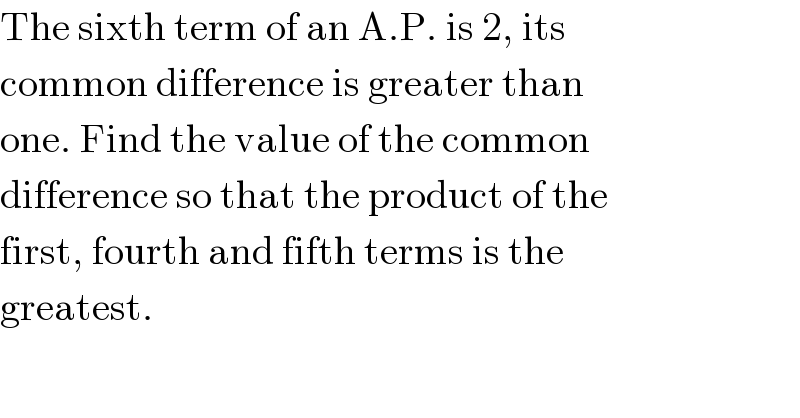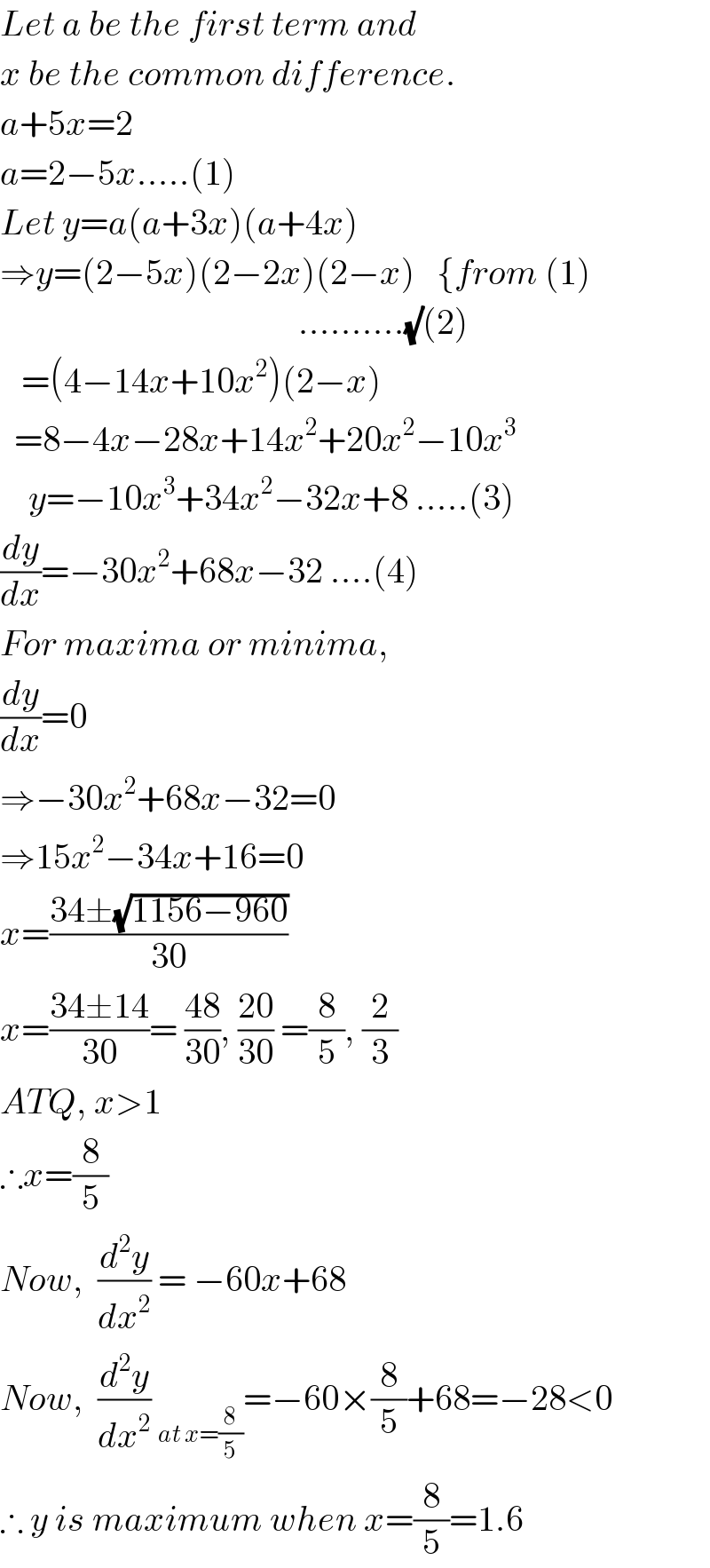Question Number 108854 by ZiYangLee last updated on 19/Aug/20

$$\mathrm{The}\:\mathrm{sixth}\:\mathrm{term}\:\mathrm{of}\:\mathrm{an}\:\mathrm{A}.\mathrm{P}.\:\mathrm{is}\:\mathrm{2},\:\mathrm{its} \\ $$$$\mathrm{common}\:\mathrm{difference}\:\mathrm{is}\:\mathrm{greater}\:\mathrm{than} \\ $$$$\mathrm{one}.\:\mathrm{Find}\:\mathrm{the}\:\mathrm{value}\:\mathrm{of}\:\mathrm{the}\:\mathrm{common} \\ $$$$\mathrm{difference}\:\mathrm{so}\:\mathrm{that}\:\mathrm{the}\:\mathrm{product}\:\mathrm{of}\:\mathrm{the} \\ $$$$\mathrm{first},\:\mathrm{fourth}\:\mathrm{and}\:\mathrm{fifth}\:\mathrm{terms}\:\mathrm{is}\:\mathrm{the} \\ $$$$\mathrm{greatest}. \\ $$
Answered by $@y@m last updated on 20/Aug/20

$${Let}\:{a}\:{be}\:{the}\:{first}\:{term}\:{and}\: \\ $$$${x}\:{be}\:{the}\:{common}\:{difference}. \\ $$$${a}+\mathrm{5}{x}=\mathrm{2} \\ $$$${a}=\mathrm{2}−\mathrm{5}{x}…..\left(\mathrm{1}\right) \\ $$$${Let}\:{y}={a}\left({a}+\mathrm{3}{x}\right)\left({a}+\mathrm{4}{x}\right) \\ $$$$\Rightarrow{y}=\left(\mathrm{2}−\mathrm{5}{x}\right)\left(\mathrm{2}−\mathrm{2}{x}\right)\left(\mathrm{2}−{x}\right)\:\:\:\left\{{from}\:\left(\mathrm{1}\right)\right. \\ $$$$\:\:\:\:\:\:\:\:\:\:\:\:\:\:\:\:\:\:\:\:\:\:\:\:\:\:\:\:\:\:\:\:\:\:\:\:\:\:\:\:\:\:……….\sqrt{}\left(\mathrm{2}\right) \\ $$$$\:\:\:=\left(\mathrm{4}−\mathrm{14}{x}+\mathrm{10}{x}^{\mathrm{2}} \right)\left(\mathrm{2}−{x}\right) \\ $$$$\:\:=\mathrm{8}−\mathrm{4}{x}−\mathrm{28}{x}+\mathrm{14}{x}^{\mathrm{2}} +\mathrm{20}{x}^{\mathrm{2}} −\mathrm{10}{x}^{\mathrm{3}} \\ $$$$\:\:\:\:{y}=−\mathrm{10}{x}^{\mathrm{3}} +\mathrm{34}{x}^{\mathrm{2}} −\mathrm{32}{x}+\mathrm{8}\:…..\left(\mathrm{3}\right) \\ $$$$\frac{{dy}}{{dx}}=−\mathrm{30}{x}^{\mathrm{2}} +\mathrm{68}{x}−\mathrm{32}\:….\left(\mathrm{4}\right) \\ $$$${For}\:{maxima}\:{or}\:{minima}, \\ $$$$\frac{{dy}}{{dx}}=\mathrm{0} \\ $$$$\Rightarrow−\mathrm{30}{x}^{\mathrm{2}} +\mathrm{68}{x}−\mathrm{32}=\mathrm{0} \\ $$$$\Rightarrow\mathrm{15}{x}^{\mathrm{2}} −\mathrm{34}{x}+\mathrm{16}=\mathrm{0} \\ $$$${x}=\frac{\mathrm{34}\pm\sqrt{\mathrm{1156}−\mathrm{960}}}{\mathrm{30}} \\ $$$${x}=\frac{\mathrm{34}\pm\mathrm{14}}{\mathrm{30}}=\:\frac{\mathrm{48}}{\mathrm{30}},\:\frac{\mathrm{20}}{\mathrm{30}}\:=\frac{\mathrm{8}}{\mathrm{5}},\:\frac{\mathrm{2}}{\mathrm{3}} \\ $$$${ATQ},\:{x}>\mathrm{1} \\ $$$$\therefore{x}=\frac{\mathrm{8}}{\mathrm{5}} \\ $$$${Now},\:\:\frac{{d}^{\mathrm{2}} {y}}{{dx}^{\mathrm{2}} }\:=\:−\mathrm{60}{x}+\mathrm{68} \\ $$$${Now},\:\:\frac{{d}^{\mathrm{2}} {y}}{{dx}^{\mathrm{2}} }\:_{{at}\:{x}=\frac{\mathrm{8}}{\mathrm{5}}} =−\mathrm{60}×\frac{\mathrm{8}}{\mathrm{5}}+\mathrm{68}=−\mathrm{28}<\mathrm{0} \\ $$$$\therefore\:{y}\:{is}\:{maximum}\:{when}\:{x}=\frac{\mathrm{8}}{\mathrm{5}}=\mathrm{1}.\mathrm{6} \\ $$
